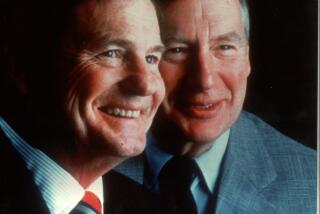C-SPANing the Gulf : While CNN gets headlines, the other news network quietly expands its profile
- Share via
C-SPAN has been heralded along with CNN by media critics as a smart choice for television viewers who want to stay briefed on events in the Persian Gulf.
The only problem is, after more than a decade many people still aren’t quite sure what C-SPAN is.
“The majority of people don’t know anything about C-SPAN--who owns it, who runs it, how it got there,” said Brian Lamb, the cable network’s founder and chief executive officer. “The biggest misperception of all is that C-SPAN is somehow owned and operated by the federal government, and that’s a notion we have vigorously tried to set the record straight on. C-SPAN was created by the cable industry as a public service.”
The Cable Satellite Public Affairs Network, as it is formally known, was established in 1979 with funding from the cable television industry to provide live, gavel-to-gavel coverage of the U.S. House of Representatives. In 1986, C-SPAN II was added to cablecast sessions of the U.S. Senate in their entirety.
What started out as a novelty has turned into something of a cult among political insiders. “It really is television for the record,” said Washington Post TV columnist John Carmody. “All the others filter news through somebody. This is the real straight dope. It’s certainly got political reality in Washington, without any fig leaf at all.”
C-SPAN’s profile was heightened during the Jan. 10 congressional debate on authorization of military force in the Persian Gulf, as cable operators were scrambling for the network’s complete Senate coverage. C-SPAN II, with 22.3 million subscribers compared to C-SPAN’s 51.7 million, swelled by 9.3 million households as 240 cable systems bumped other programming to temporarily pick up the service.
But the coverage didn’t end with the congressional debates. The network’s special Gulf War coverage includes nightly military briefings, major Gulf news, anti- and pro-war rallies, pool footage of military operations and loads of expert analysis and commentary.
C-SPAN specializes in viewer call-in programs. When war broke out, the network put on an endless stream of viewer phone calls around-the-clock.
“Our first instinct was to open the telephone lines and listen to the public for a long time, because we are not a primary source of basic news,” Lamb said. “We are an alternative to the other networks. ... The last thing this country needs is another copy of what they see on four other channels.”
In the first week of Operation Desert Storm, C-SPAN aired out the opinions of more than 1,600 callers. “It was a national catharsis,” Lamb said. “We did the same during the Challenger accident and during political conventions. There are a certain number of people who get extremely irritated when they watch a public event, like the President speaking to the nation, and then a high-priced television personality comes on screen and tells them what they just saw.”
C-SPAN spokeswoman Rayne Pollack calls the network “the place where the nation can come and hold a town meeting.”
KFI-AM (640) talk-show host Tom Leykis, who hosted a version of his radio program on C-SPAN last month, said: “The best part of C-SPAN is not the talk shows by any stretch. It’s watching the Senate and the House. It’s seeing how the government works. When I was in Washington, C-SPAN to the community there was like MTV is to us in Hollywood. They all watch it. They all watch each other on it.”
The building that houses C-SPAN’s small staff of 170 employees, in fact, is just two blocks from the Capitol in the Hall of States Building. “You can see the dome of the Capitol from out of our offices, which is always a reminder to us where our roots are,” said vice president Susan Swain.
She pointed out that C-SPAN’s low annual budget of $15 million “would be in the same neighborhood if you added up the salaries of the three network news anchors.” C-SPAN’s operations are so lean that Lamb and Swain double as on-air interviewers. The five other on-air talents also have dual jobs behind the scenes; one is C-SPAN’s legal counsel.
“We’re funded by the cable industry, and for us to stick around our value has to be in excess of our cost,” Lamb said. “If we lose sight of that there will be a great deal of friction between the people who pay our bills and those of us who run the network.”
Lamb says C-SPAN is so successful at what it does that in the last two years 35 representatives from different countries have stopped by C-SPAN’s offices to check out operations. When other countries such as Great Britain, Canada and Japan began similar programming, C-SPAN carried it to let Americans see how other country’s governments work. One of C-SPAN’s most popular programs is Sunday night’s “Question Time,” when the imperious British House of Commons raucously fires questions at Prime Minister John Major.
“We have become, like this country I guess, kind of an example to the rest of the world of how you can have television devoted to in-depth discussion and carriage of events in politics without being controlled by the government,” Lamb said.
“We came of age, among journalists, in 1984,” Swain said, referring to the news media’s support of C-SPAN. “I remember vividly going to the Democratic convention and walking from booth to booth where all the print reporters were. And instead of sitting out on the floor, they were in their booths watching C-SPAN’s coverage of the convention. They realized what we were trying to do.”
One of the drawbacks of C-SPAN’s one-camera, fly-on-the-wall style of television is that it’s not always the most exciting to watch. In large part, C-SPAN consists of an electronic population of talking heads.
The Washington Post has reported that the three broadcast networks used C-SPAN’s long-form coverage as an excuse to cut back on their own reporting of political routine.
“C-SPAN is a marvelous little instrument, tremendously more valuable than CNN and the like,” Carmody of The Post said. “Whether it’s boring or not, that’s something else again. Its limitation is its entertainment quotient, and the medium is essentially entertainment. You have to sift through C-SPAN. I must confess, listening to someone drone on and on, I want the camera to cut to the audience sometimes to see if they’re fairing any better than I am.”
Said Lamb: “There’s a wide perception that C-SPAN is dull, boring, uninteresting. That comes from people who usually don’t care about politics, who don’t vote, who are afraid that they don’t know what they’re watching.”
Not surprisingly, C-SPAN viewers are more politically active than the norm. The University of Maryland Survey Research Center found that 92% of C-SPAN viewers voted in the 1988 presidential elections, compared to 49% nationwide. What’s more, 26% of those viewers said the network’s election programming affected whom they voted for.
“We feel like if we don’t get you now, we’re going to get you later,” Swain said. “Public policy affects everyone--whether you’re a business person and it’s tax policy, you’re a farmer and it’s an agricultural hearing, or you’re into rock music and it’s an issue of lyric labeling.”
Swain said the main frustration for C-SPAN viewers is simply knowing when to tune in to the parade of press conferences, speeches, hearings, conventions, rallies and debates. Although there is some consistent programming, trying to predict the daily C-SPAN lineup is like trying to predict the day’s news. The network is researching different electronic devices, such as on-screen graphics, closed-caption decoders and computer bulletin boards, to let people know when to watch what. Nothing has been announced yet.
Because there are no advertisers on C-SPAN, the network doesn’t subscribe to ratings services, so it doesn’t actually know how big its audience is. But Swain said the network’s latest research, conducted the last week of January, shows that 29% of cable viewers surveyed reported watching C-SPAN in the past six months, compared to 18% in 1988. And 85% of C-SPAN households tuned into the network’s coverage of the congressional debate over war in the Persian Gulf.
“There’s been an awful lot going on--the Senate Ethics Committee, which people followed like a soap opera, the huge debate over the budget in October, and now the Persian Gulf,” Swain said.
Even though other news sources say they are dedicated to giving complete coverage in the Gulf, Swain said that C-SPAN will be there for the long haul. “We’re going to keep on covering the Pentagon and Saudi Arabia no matter how long this lasts,” she said. “The networks have to start backing away as time goes on because of commercial needs, as their audience dwindles. That’s why we’re unfettered. We don’t need to deliver eyeballs to advertisers, even though the coverage may not be as compelling as time marches on.”
Many critics have suggested that perhaps C-SPAN’s most valuable asset is its detailed documentation of historical events. The network works closely with high schools across the nation to integrate C-SPAN programming as an educational tool. Aware of C-SPAN’s enormous educational possibilities, Lamb began compiling a videotape archive four years ago, now 50,000 tapes strong, at Purdue University in Lafayette, Ind.
“We look at ourselves as a repository for history,” Lamb said. “The history of the moment will always be there on videotape.”
Who Watches C-SPAN?
Age:
71% are under 50
40% are 18-34
Sex:
58% male
42% female
Voting habits:
74% voted in 1990 (compared to 36% of the nation)
Political affiliation:
34% Democrat
33% Republican
24% Independent
9% other
Highest level of education achieved:
13% graduate degrees
24% college graduates
32% some college
25% high school graduates
6% no formal education
Annual income:
16% earn less than $20,000
18% earn $20,000-29,000
14% earn $30,000-39,000
17% earn $40,000-49,000
26% earn $50,000-74,000
9% did not report
Data was compiled by Statistical Research Inc. of New Jersey through a random-dialed national survey of 1,053 households that received C-SPAN during the last week of January.
More to Read
The biggest entertainment stories
Get our big stories about Hollywood, film, television, music, arts, culture and more right in your inbox as soon as they publish.
You may occasionally receive promotional content from the Los Angeles Times.










